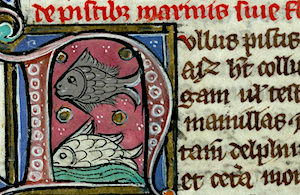Octopus, (ὀκτάπους, ὀκταπόδιον, πολύπους, which could designate any many-legged creature but also an octopus, etc.), considered to be one of the fishes, was no stranger to the Byzantines. It formed part of the diet (however, as Niketas Choniates implies, the taste of a raw octopus was considered horrible[1]); one of the imperial banners was customarily called “octopus” because it was divided into eight parts.[2] Moreover, some texts offer us a glimpse into how fishermen handled octopuses (see Theodore Prodromos, Historical Poem, no. 78).
Βits and pieces of information about octopuses are scattered throughout texts of various genres: historiography, poetry, monastic typika. To some extent, they reflect rather widespread knowledge about octopuses, such as their ability to change colors, to cling to rocks (which probably became proverbial as it appears in various texts and is also elaborated in the Evergetis typikon).[3] Some works, however, offer more detailed information (e.g., Michael Psellos about releasing water through an orifice in heads, John Tzetzes about octopuses laying eggs). Perhaps the two most detailed descriptions of this species, which will be analyzed in this presentation, were penned by Michael Glykas (12th century) in his Chronicle and Manuel Philes (13th/14thcentury) in On the Proprieties of Animals.
Most of this knowledge goes back to ancient authors writing about octopuses: Aristotle, Theophrastus, Plinius, Oppian. In some cases, ancient sources were explicitly mentioned (as in Glykas' case, who refers to Aristotle), sometimes ancient authors remain undisclosed. Finally, texts, which were not primarily meant to discuss/transmit any zoological knowledge, convey popular views (which in most cases were also based on ancient works). This paper aims to demonstrate the Byzantine knowledge about octopuses, its potential ancient sources, and various ways of repurposing this knowledge for Byzantine readers.
- Poster

 PDF version
PDF version
